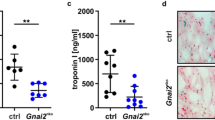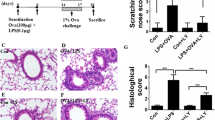Abstract
Adenosine is a potent inhibitor of reactive oxygen species (ROS) production by the NADPH oxidase in fMLF-stimulated neutrophils. Although much is known about the pharamacology and signal transduction of this effect, it is not known how adenosine affects assembly and localization of the NADPH oxidase components within the neutrophil. We report here that adenosine pretreatment of fMLF-stimulated neutrophils results in decreased plasma membrane/secretory granule content of the flavocytochrome b components (p22phox and gp91phox) of the NADPH oxidase, which correlates with inhibition of ROS production. Adenosine treatment did not affect upregulation of secretory and specific granule surface markers, confirming that degranulation was not impaired by adenosine. However, adenosine treatment did result in increased movement of cell-surface flavocytochrome b to heavy granule fractions in fMLF-stimulated neutrophils. These data suggest that adenosine-mediated effects on neutrophil ROS production are due, in part to endocytosis and/or redistribution of flavocytochrome b between various subcellular compartments.
Similar content being viewed by others
REFERENCES
Witko-Sarsat, V., P. Rieu, B. Descamps-Latscha, P. Lesavre, and L. Halbwachs-Mecarelli. 2000. Neutrophils: Molecules, functions and pathophysiological aspects. Lab. Invest. 80:617-653.
Burg, N. D., and M. H. Pillinger. 2001. The neutrophil: Function and regulation in innate and humoral immunity. Clin. Immunol. 99:7-17.
Ali, H., B. Haribabu, R. M. Richardson, and R. Snyderman. 1997. Mechanisms of inflammation and leukocyte activation. Med. Clin. North Am. 81:1-28.
Ricevuti, G. 1997. Host tissue damage by phagocytes. Ann. N.Y. Acad. Sci. 832:426-448.
Babior, B. M. 2000. Phagocytes and oxidative stress. Am. J. Med. 109:33-34.
Clark, R. A. 1999. Activation of the neutrophil respiratory burst oxidase. J. Infect. Dis. 179:S309-S317.
Nauseef, W. M. 1999. The NADPH-dependent oxidase of phagocytes. Proc. Assoc. Am. Physicians 111:373-382.
Jesaitis, A. J. 1995. Structure of human phagocyte cytochrome b and its relationship to microbicidal superoxide production. J. Immunol. 155:3286-3288.
Clark, R. A. 1999. Activation of the neutrophil respiratory burst oxidase. J. Infect. Dis. 179:S309-S317.
DeLeo, F. R., and M. T. Quinn. 1996. Assembly of the phagocyte NADPH oxidase: Molecular interaction of oxidase proteins. J. Leukoc. Biol. 60:677-691.
Bouma, M. G., F. A. van den Wildenberg, and W. A. Buurman. 1997. The anti-inflammatory potential of adenosine in ischemiareperfusion injury: established and putative beneficial actions of a retaliatory metabolite. Shock 8:313-320.
Cronstein, B. N., R. I. Levin, M. Philips, R. Hirschhorn, S. B. Abramson, and G. Weissmann. 1992. Neutrophil adherence to endothelium is enhanced via adenosine A1 receptors and inhibited via adenosine A2 receptors. J. Immunol. 148:2201-2206.
Tsuruta, S., S. Ito, and H. Mikawa. 1993. Effects of adenosine and its analogues on actin polymerization in human polymorphonuclear leucocytes. Clin. Exp. Pharmacol. Physiol. 20:89-94.
Stewart, A. G., and T. Harris. 1993. Adenosine inhibits plateletactivating factor, but not tumour necrosis factor-alpha-induced priming of human neutrophils. Immunology 78:152-158.
Barnes, C. R., G. L. Mandell, H. T. Carper, S. Luong, and G. W. Sullivan. 1995. Adenosine modulation of tumor necrosis factor-alpha-induced neutrophil activation. Biochem. Pharmacol. 50:1851-1857.
Cronstein, B. N., S. B. Kramer, G. Weissmann, and Hirschhorn, R. 1983. Adenosine: A physiological modulator of superoxide anion generation by human neutrophils. J. Exp. Med. 158:1160-1177.
Richter, J. 1992. Effect of adenosine analogues and cAMP-raising agents on TNF-, GM-CSF-, and chemotactic peptide-induced degranulation in single adherent neutrophils. J. Leukoc. Biol. 51:270-275.
Ottonello, L., P. Barbera, P. Dapino, C. Sacchetti, and F. Dallegri. 1997. Chemoattractant-induced release of elastase by lipopolysaccharide (LPS)-primed neutrophils; inhibitory effect of the antiinflammatory drug nimesulide. Clin. Exp. Immunol. 110:139-143.
Cronstein, B. N. 1994. Adenosine, an endogenous anti-inflammatory agent. J. Appl. Physiol. 76:5-13.
Cronstein. B. N., L. Daguma, D. Nichols, A. J. Hutchison, and M. Williams. 1990. The adenosine ?neutrophil paradox resolved: human neutrophils possess both A1 and A2 receptors that promote chemotaxis and inhibit O2 generation, respectively. J. Clin. Invest. 85:1150-1157.
Burkey, T. H., and R. O. Webster. 1993. Adenosine inhibits fMLPstimulated adherence and superoxide anion generation by human neutrophils at an early step in signal transduction. Biochim. Biophys. Acta 1175:312-318.
Fredholm, B. B. 1997. Purines and neutrophil leukocytes. Gen. Pharmacol. 28:345-350.
Revan, S., M. C. Montesinos, D. Naime, S. Landau, and B. N. Cronstein. 1996. Adenosine A2 receptor occupancy regulates stimulated neutrophil function via activation of a serine /threonine protein phosphatase. J. Biol. Chem. 271:17114-17118.
Nakamura, M., M. Murakami, T. Koga, Y. Tanaka, and S. Minakami. 1987. Monoclonal antibody 7D5 raised to cytochrome b558 of human neutrophils: Immunocytochemical detection of the antigen in peripheral phagocytes of normal subjects, patients with chronic granulomatous disease, and their carrier mothers. Blood 69:1404-1408.
Burritt, J. B., M. T. Quinn, M. A. Jutila, C. W. Bond, and A. J. Jesaitis. 1995. Topological mapping of neutrophil cytochrome b epitopes with phage-display libraries. J. Biol. Chem. 270:16974-16980.
DeLeo, F. R., L. Yu, J. B. Burritt, L. R. Loetterle, C. W. Bond, A. J. Jesaitis, and M. T. Quinn. 1995. Mapping sites of interaction of p47-phox and flavocytochrome b with random-sequence peptide phage display libraries. Proc. Natl. Acad. Sci. USA 92:7110-7114.
DeLeo, F. R. M. A. Jutila, and M. T. Quinn. 1996.Characterization of peptide diffusion into electropermeabilized neutrophils. J. Immunol. Methods 198:35-49.
Liu, L., C. Dahlgren, H. Elwing, and H. Lundqvist. 1996. A simple chemiluminescence assay for the determination of reactive oxygen species produced by human neutrophils. J. Immunol. Methods 192:173-178.
Dahlgren, C., and A. Karlsson. 1999. Respiratory burst in human neutrophils. J. Immunol. Methods 232:3-14.
Lundqvist, H., and C. Dahlgren. 1996. Isoluminol-enhanced chemiluminescence: A sensitive method to study the release of superoxide anion from human neutrophils. Free Radical Biology and Medicine 20:785-792.
Quinn, M. T., C. A. Parkos, and A. J. Jesaitis. 1989. The lateral organization of components of the membrane skeleton and superoxide generation in the plasma membrane of stimulated human neutrophils. Biochim. Biophys. Acta 987:83-94.
Kjeldsen, L., H. Sengelov, and N. Borregaard. 1999. Subcellular Swain, Siemsen, Nelson, Sipes, Hanson, and Quinn 58 fractionation of human neutrophils on Percoll density gradients. J. Immunol. Methods 232:131-143.
Swain, S. D., K. L. Jutila, and M. T. Quinn. 2000. Cell-surface lactoferrin as a marker for bovine neutrophil degranulation: Development of a monoclonal antibody and flow cytometric assay. Am. J. Vet. Rev. 61:29-37.
Swain, S. D., P. L. Bunger, K. M. Sipes, L. K. Nelson, K. L. Jutila, S. M. Boylan, and M. T. Quinn. 1998. Platelet-activating factor induces a concentration-dependent spectrum of functional responses in bovine neutrophils. J. Leukoc. Biol. 64:817-827.
DeLeo, F. R., K. V. Ulman, A. R. Davis, K. L. Jutila, and M. T. Quinn. 1996. Assembly of the human neutrophil NADPH oxidase involves binding of p67phox and flavocytochrome b to a common functional domain in p47phox. J. Biol. Chem. 271:17013-17020.
Zalavary, S., and T. Bengtsson. 1998. Modulation of the chemotactic peptide-and immunoglobulin G-triggered respiratory burst in human neutrophils by exogenous and endogenous adenosine. Eur. J. Pharmacol. 354:215-225.
Zipfel, M., T. C. Carmine, C. Gerber, and G. Bruchelt. 1997. Evidence for the activation of myeloperoxidase by f-Meth-Leu-Phe prior to its release from neutrophil granulocytes. Biochem. Biophys. Res. Commun. 232:209-212.
Sengelov, H., L. Kjeldsen, W. Kroeze, M. Berger, and N. Borregaard. 1994. Secretory vesicles are the intracellular reservoir of complement receptor 1 in human neutrophils. J. Immunol. 153:804-810.
Martens, A., G. J. M. Eppink, A. J. J. Woittiez, H. Eidhof, and L. F. M. H. DeLeij. 1999. Neutrophil function capacity to express CD10 is decreased in patients with septic shock. Crit. Care Med. 27:549-553.
Afeltra, A., D. Caccavo, G. M. Ferri, M. A. Addessi, F. G. DeRosa, A. Amoroso, and L. Bonomo. 1997. Expression of lactoferrin on human granulocytes: Analysis with polyclonal and monoclonal antibodies. Clin. Exp. Immunol. 109:279-285.
Sengelov, H., L. Kjeldsen, M. S. Diamond, T. A. Springer, and N. Borregaard. 1993. Subcellular localization and dynamics of Mac-1 (?m?2) in human neutrophils. J. Clin. Invest. 92:1467-1476.
DeLeo, F. R., J. Renee, S. McCormick, M. Nakamura, M. Apicella, J. P. Weiss, and W. M. Nauseef. 1998. Neutrophils exposed to bacterial lipopolysaccharide upregulate NADPH oxidase assembly. J. Clin. Invest. 101:455-463.
Akard, L. P., D. English, and T. G. Gabig. 1988. Rapid deactivation of NADPH oxidase in neutrophils: Continuous replacement by newly activated enzyme sustains the respiratory burst. Blood 72:322-327.
Quinn, M. T., T. Evans, L. R. Loetterle, A. J. Jesaitis, and G. M. Bokoch. 1993. Translocation of Rac correlates with NADPH oxidase activation: Evidence for equimolar translocation of oxidase components. J. Biol. Chem. 268:20983-20987.
Jesaitis, A. J., E. S. Buescher, D. Harrison, M. T. Quinn, C. A. Parkos, S. Livesey, and J. Linner. 1990. Ultrastructural localization of cytochrome b in the membranes of resting and phagocytosing human granulocytes. J. Clin. Invest. 85:821-835.
Ohno, Y., B. E. Seligmann, and J. I. Gallin. 1985. Cytochrome b translocation to human neutrophil plasma membranes and superoxide release. Differential effects of N-formymethionylleucylphenylalanine, phorbol myristate acetate, and A23187. J. Biol. Chem. 201:2409-2414.
Vaissiere, C., V. LeCabec, and I. Maridonneau-Parini. 1999. NADPH oxidase is functionally assembled in specific granules during activation of human neutrophils. J. Leukoc. Biol. 65:629-634.
Borregaard, N., J. M. Heiple, E. R. Simons, and R. A. Clark. 1983. Subcellular localization of the b-cytochrome component of the human neutrophil microbicidaz oxidase: Translocation during activation. J. Cell. Biol. 97:52-61.
Borregaard, N., K. Lollike, L. Kjeldsen, H. Sengelov, L. Bastholm, M. H. Nielsen, and D. F. Bainton. 1993. Human neutrophil granules and secretory vesicles. Eur. J. Haematol. 51:187-198.
Borregaard, N., L. Kjeldsen, H. Sengelov, M. S. Diamond, T. A. Springer, H. C. Anderson, T. K. Kishimoto, and D. F. Bainton. 1994. Changes in subcellular localization and surface expression of L-selectin, alkaline phosphatase, and Mac-1 in human neutrophils during stimulation with inflammatory mediators. J. Leukoc. Biol. 56:80-87.
Chambers, J. D., S. I. Simon, E. M. Berger, L. A. Sklar, and K. E. Arfors. 1993. Endocytosis of ? 2 integrins by stimulated human neutrophils analyzed by flow cytometry. J. Leukoc. Biol. 53:462-469.
Berger, M., E. M. Wetzler, E. Welter, J. R. Turner, and A. M. Tartakoff.Intracellular sites for storage and recycling of C3b receptors in human neutrophils. 1991. Proc. Natl. Acad. Sci. USA 88:3019-3023.
Kobayashi, T., and J. M. Robinson. 1991. A novel intracellular compartment with unusual secretory properties in human neutrophils. J. Cell Biol. 113:743-756.
Fernández-Segura, E., J. M. García, and A. Campos. 1995. Dynamic reorganization of the alkaline phosphatase-containing compartment during chemotactic peptide stimulation of human neutrophils imaged by backscattered electrons. Histochem. Cell Biol. 104:175-181.
Kobayashi, T., J. M. Robinson, and H. Seguchi. 1998. Identification of intracellular sites of superoxide production in stimulated neutrophils. J. Cell Sci. 111:81-91.
Kobayashi, T., and H. Seguchi. 1999. Novel insight into current models of NADPH oxidase regulation, assembly and localization in human polymorphonuclear leukocytes. Histol. Histopathol. 14:1295-1308.
Sengelov, H. and N. Borregaard. 1999. Free-flow electrophoresis in subcellular fractionation of human neutrophils. J. Immunol. Methods 232:145-152.
Borregaard, N., L. Christensen, O. W. Bjerrum, H. S. Birgens, and I. Clemmensen. 1990. Identification of a highly mobilizable subset of human neutrophil intracellular vesicles that contains tetranectin and latent alkaline phosphatase. J. Clin. Invest. 85:408-416.
Vita, F., M. R. Soranzo, V. Borelli, P. Bertoncin, and G. Zabucchi. 1996. Subcellular localization of the small GTPase Rab5a in resting and stimulated human neutrophils. Exp. Cell Res. 227:367-373.
Author information
Authors and Affiliations
Corresponding author
Rights and permissions
About this article
Cite this article
Swain, S.D., Siemsen, D.W., Nelson, L.K. et al. Inhibition of the Neutrophil NADPH Oxidase by Adenosine Is Associated with Increased Movement of Flavocytochrome b Between Subcellular Fractions. Inflammation 27, 45–58 (2003). https://doi.org/10.1023/A:1022639228723
Issue Date:
DOI: https://doi.org/10.1023/A:1022639228723




